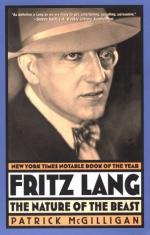|
This section contains 189 words (approx. 1 page at 300 words per page) |
Widely influential filmmaker Fritz Lang fled Nazi Germany in 1932, eventually settling in Hollywood where he made over 20 films. His crime dramas, including thrillers like The Big Heat (1953), spawned generations of imitators, giving rise to the category of movies known as film noir. Lang crafted his distinct visual style in Berlin during the 1920s, translating onto film the exaggerated emotions and vivid imagery of German Expressionist painting. He set crucial scenes in cramped stairways and corridors and employed varying camera angles and starkly contrasting light and shadow for effect. In the silent film Metropolis (1926) he created an archetype for the city of the future, complete with a slave class of machine-like workers and a cyborg temptress. M (1931), which features Peter Lorre as a child murderer hounded by society, effectively foreshadowed the threatening environment fostered in Germany in the years leading up to the Second World War.
Further Reading:
Humphries, Reynold. Fritz Lang: Genre and Representation in His American Films. Baltimore, Johns Hopkins, 1988.
Kaplan, Ann. Fritz Lang: A Guide to References and Resources. Boston, G.K. Hall, 1981.
Weinberg, Herman. Fritz Lang. N.p., Gordon Press, 1979.
|
This section contains 189 words (approx. 1 page at 300 words per page) |


